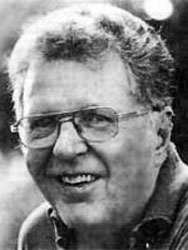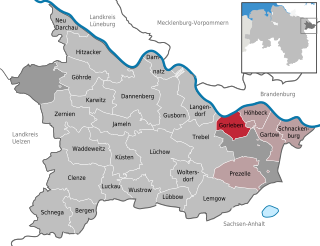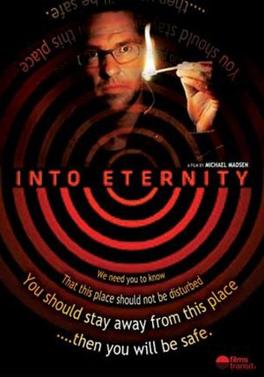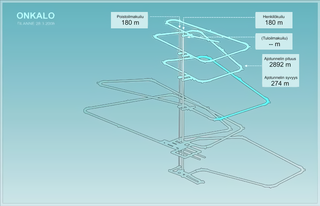
Radioactive waste is a type of hazardous waste that contains radioactive material. Radioactive waste is a result of many activities, including nuclear medicine, nuclear research, nuclear power generation, nuclear decommissioning, rare-earth mining, and nuclear weapons reprocessing. The storage and disposal of radioactive waste is regulated by government agencies in order to protect human health and the environment.

The Yucca Mountain Nuclear Waste Repository, as designated by the Nuclear Waste Policy Act amendments of 1987, is a proposed deep geological repository storage facility within Yucca Mountain for spent nuclear fuel and other high-level radioactive waste in the United States. The site is on federal land adjacent to the Nevada Test Site in Nye County, Nevada, about 80 mi (130 km) northwest of the Las Vegas Valley.

Walter Michael Miller Jr. was an American science fiction writer. His fix-up novel, A Canticle for Leibowitz (1959), the only novel published in his lifetime, won the 1961 Hugo Award for Best Novel. Prior to its publication, he was a writer of short stories.

Hans Jonas was a German-born American Jewish philosopher. From 1955 to 1976 he was the Alvin Johnson Professor of Philosophy at the New School for Social Research in New York City.

The Waste Isolation Pilot Plant, or WIPP, is the world's third deep geological repository licensed to store transuranic radioactive waste for 10,000 years. The storage rooms at the WIPP are 2,150 feet underground in a salt formation of the Delaware Basin. The waste is from the research and production of United States nuclear weapons only. The plant started operation in 1999, and the project is estimated to cost $19 billion in total.
Ocean floor disposal is a method of sequestering radioactive waste in ocean floor sediment where it is unlikely to be disturbed either geologically or by human activity.

Thomas Albert Sebeok was a Hungarian-born American polymath, semiotician, and linguist. As one of the founders of the biosemiotics field, he studied non-human and cross-species signaling and communication. He is also known for his work in the development of long-time nuclear waste warning messages, in which he worked with the Human Interference Task Force to create methods for keeping the inhabitants of Earth away from buried nuclear waste that will still be hazardous 10,000 or more years in the future.

The Nuclear Waste Policy Act of 1982 is a United States federal law which established a comprehensive national program for the safe, permanent disposal of highly radioactive wastes.

A deep geological repository is a way of storing hazardous or radioactive waste within a stable geologic environment. It entails a combination of waste form, waste package, engineered seals and geology that is suited to provide a high level of long-term isolation and containment without future maintenance. This will prevent any radioactive dangers. A number of mercury, cyanide and arsenic waste repositories are operating worldwide including Canada and Germany and a number of radioactive waste storage sites are under construction with the Onkalo in Finland being the most advanced.

Gorleben is a small municipality (Gemeinde) in the Gartow region of the Lüchow-Dannenberg district in the far north-east of Lower Saxony, Germany, a region also known as the Wendland.

Günther Anders was a German-born philosopher, journalist and critical theorist.

High-level radioactive waste management addresses the handling of radioactive materials generated from nuclear power production and nuclear weapons manufacture. Radioactive waste contains both short-lived and long-lived radionuclides, as well as non-radioactive nuclides. In 2002, the United States stored approximately 47,000 tonnes of high-level radioactive waste.
The Deep Geologic Repository Project (DGR) was a proposal by Ontario Power Generation (OPG) in 2002 for the site preparation, construction, operation, decommissioning and abandonment of a deep geological radioactive waste disposal facility for low and intermediate-level radioactive waste (L&ILW). In 2005, the municipality of Kincardine, Ontario volunteered to host the facility located on the Bruce nuclear generating station adjacent to OPG's Western Waste Management Facility (WWMF). The facility would have managed L&ILW produced from the continued operation of OPG-owned nuclear generating stations at the Bruce, Pickering Nuclear Generating Station and Darlington Nuclear Generating Station in Ontario. In May 2020, after 15 years of environmental assessment, OPG withdrew its application for a construction license on Saugeen Ojibway Nation Territory.

Into Eternity is a 2010 Danish documentary film directed by Michael Madsen, released in 2010. It follows the construction of the Onkalo waste repository at the Olkiluoto Nuclear Power Plant on the island of Olkiluoto, Finland. Director Michael Madsen questions Onkalo's intended eternal existence, addressing an audience in the remote future.

The Onkalo spent nuclear fuel repository is a deep geological repository for the final disposal of spent nuclear fuel. It is near the Olkiluoto Nuclear Power Plant in the municipality of Eurajoki, on the west coast of Finland. It will be the world's first long-term disposal facility for spent nuclear fuel. It is being constructed by Posiva, and is based on the KBS-3 method of nuclear waste burial developed in Sweden by Svensk Kärnbränslehantering AB (SKB). The facility is expected to be operational in the mid 2020s.

Long-term nuclear waste warning messages are communication attempts intended to deter human intrusion at nuclear waste repositories in the far future, within or above the order of magnitude of 10,000 years. Nuclear semiotics is an interdisciplinary field of research, first done by the American Human Interference Task Force in 1981.
The Czech Radioactive Waste Repository Authority was established on 1 June 1997 as a state organisation established by the Ministry of Industry and Trade. In 2001, SÚRAO assumed the status of a government agency. The Authority is headed by its managing director, Dr. Jiří Slovák. The governing body of SÚRAO consists of its Board which is made up of representatives from the government, radioactive waste producers and the general public. The managing director and members of the Board of SÚRAO are directly appointed by the Minister of Industry and Trade.
Vincent Ialenti is an American anthropologist who studies the culture of nuclear energy and weapons waste organizations. He is the author of Deep Time Reckoning, an anthropological exploration of how experts assessed the potential impact of Finland's Onkalo spent nuclear fuel repository on future ecosystems and civilization.

A ray cat is a proposed kind of cat that would be genetically engineered to change appearance in the presence of nuclear radiation. Philosophers Françoise Bastide and Paolo Fabbri originated the idea of a "living radiation detector" in 1984 as a proposed long-time nuclear waste warning message that could be understood 10,000 years in the future, building on the Human Interference Task Force's idea of oral transmission of radiation's dangers. Bastide and Fabbri did not specify a particular animal to be used, but coined the term "ray cat" to illustrate how name choice could convey the animal's function. They also did not specify how the animals' appearance should change, but ray cats are often conceived of as either changing color or glowing.
The Promethean gap is a concept concerning the relations of humans and technology and a growing "asynchronization" between them. In popular formulations, the gap refers to an inability or incapacity of human faculties to imagine the effects of the technologies that humans produce, specifically the negative effects. The concept originated with philosopher Günther Anders in the 1950s and for him, an extreme test case was the atomic bomb and its use at Hiroshima and Nagasaki in 1945, a symbol of the larger technology revolution that the 20th century was witnessing. The gap has been extended to and understood within multiple variations – a gap between production and ideology; production and imagination; production and need; production and use; technology and the body; doing and imagining; and doing and feeling. The gap can also be seen in areas such as law and in the actions of legislatures and policymakers.














